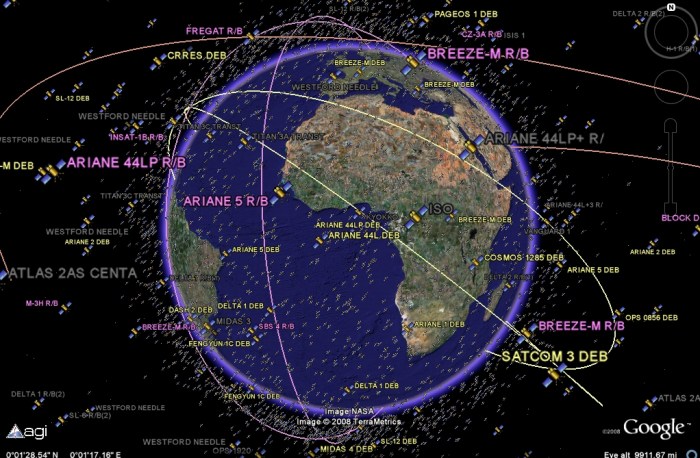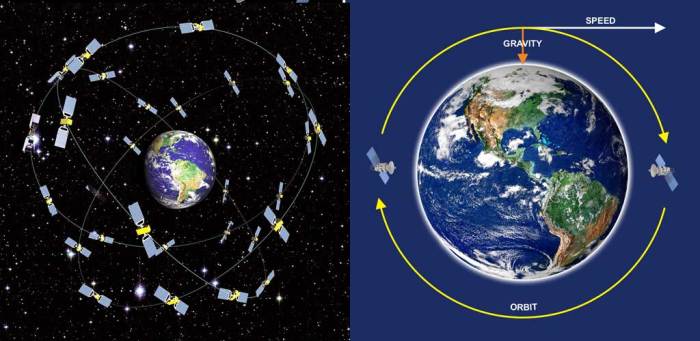Orbits of satellites quick check – Embarking on a captivating journey into the realm of orbits of satellites, this quick check delves into the intricate dance of celestial bodies and their gravitational interplay. By unraveling Kepler’s Laws of Planetary Motion, we lay the foundation for understanding the elliptical paths traced by satellites as they traverse the vast expanse of space.
From geostationary orbits that hover over a fixed point on Earth’s equator to low Earth orbits (LEOs) enabling real-time Earth observation, the diversity of satellite orbits caters to a myriad of applications. Factors such as Earth’s gravity, atmospheric drag, and solar radiation pressure shape the trajectories of these satellites, influencing their orbital periods and characteristics.
Kepler’s Laws of Planetary Motion
Kepler’s Laws of Planetary Motion provide a fundamental understanding of the dynamics of celestial bodies, including satellites orbiting Earth.
Kepler’s First Law: The Law of Ellipses
Kepler’s First Law states that the orbit of every planet around the Sun is an ellipse, with the Sun located at one focus of the ellipse.
Kepler’s Second Law: The Law of Equal Areas
Kepler’s Second Law states that a line connecting a planet to the Sun sweeps out equal areas in equal intervals of time, indicating that the planet’s orbital velocity varies throughout its orbit.
Kepler’s Third Law: The Law of Harmonies
Kepler’s Third Law states that the square of the orbital period of a planet is proportional to the cube of its average distance from the Sun.
Types of Satellite Orbits

Geostationary Orbits (GEOs)
GEOs are circular orbits located approximately 35,786 kilometers above Earth’s equator. Satellites in GEOs maintain a fixed position relative to Earth’s surface, making them ideal for communication and broadcasting.
Low Earth Orbits (LEOs)
LEOs are circular or elliptical orbits ranging from 200 to 2,000 kilometers above Earth’s surface. LEOs are used for a wide range of applications, including Earth observation, remote sensing, and navigation.
Medium Earth Orbits (MEOs)
MEOs are circular or elliptical orbits ranging from 2,000 to 35,786 kilometers above Earth’s surface. MEOs are often used for navigation and positioning systems, as they provide a balance between coverage and signal delay.
Highly Elliptical Orbits (HEOs)
HEOs are elliptical orbits with high eccentricity, allowing satellites to spend a significant amount of time at apogee, the farthest point from Earth. HEOs are used for scientific research and exploration, as they provide extended observation periods.
Factors Affecting Satellite Orbits

Earth’s Gravity
Earth’s gravity exerts a primary force on satellites, causing them to orbit in elliptical or circular paths.
Atmospheric Drag, Orbits of satellites quick check
Atmospheric drag, though minimal at higher altitudes, can gradually alter satellite orbits over time, especially for satellites in LEOs.
Solar Radiation Pressure
Solar radiation pressure exerts a small but noticeable force on satellites, particularly those with large surface areas, causing slight changes in their orbits.
Orbital Perturbations
Orbital perturbations are small, gradual changes in a satellite’s orbit caused by factors such as the gravitational pull of other celestial bodies and the Earth’s oblateness.
Applications of Satellite Orbits: Orbits Of Satellites Quick Check

Geostationary Satellites
GEOs are primarily used for communication and broadcasting, providing a stable and reliable platform for satellite television, radio, and internet services.
Low Earth Satellites
LEOs are extensively used for Earth observation, remote sensing, and environmental monitoring. They provide detailed images and data for various applications, including weather forecasting, disaster response, and resource management.
Medium Earth Satellites
MEOs are employed in navigation and positioning systems, such as the Global Positioning System (GPS). They provide precise location and timing information for a wide range of applications.
Highly Elliptical Satellites
HEOs are used for scientific research and exploration. They enable scientists to study Earth’s magnetic field, space weather, and other phenomena over extended periods.
Question Bank
What is the significance of Kepler’s Laws in understanding satellite orbits?
Kepler’s Laws provide the mathematical framework for describing the elliptical orbits of satellites, predicting their orbital periods, and understanding the relationship between their distance from the Earth and their speed.
How do geostationary orbits differ from LEOs?
Geostationary orbits are located at an altitude of approximately 35,786 kilometers above Earth’s equator, enabling satellites to remain stationary relative to a fixed point on the ground. LEOs, on the other hand, are much closer to Earth, typically ranging from 200 to 2,000 kilometers above the surface, and complete multiple orbits each day.
What are the factors that influence the orbital periods of satellites?
The orbital period of a satellite is primarily determined by its distance from Earth. According to Kepler’s Third Law, satellites closer to Earth have shorter orbital periods, while those farther away have longer periods.